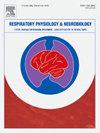心肺相同步增强后脑网络的特征。
IF 1.6
4区 医学
Q3 PHYSIOLOGY
引用次数: 0
摘要
中枢神经机制在心肺耦合中起着重要作用。脑干如何影响心肺耦合是比较清楚的,但关于心肺耦合的大脑皮层活动的研究很少。我们的目的是研究大脑皮层对心肺相同步增强的反应。采用脑网络方法,对自发性、2/2和4/4呼吸模式的全局属性和相位同步时间(CRPST)进行Pearson相关分析。计算21个脑电图导联信号的相位滞后指数(PLI),分析PLI与心血管和呼吸系统参数的相关性。结果表明,在α(8-14 Hz)波段,三种呼吸模式下的脑网络特征参数存在显著差异。在自主呼吸模式下,整体效率和特征路径长度与相同步显著正相关,PLI指数与CRPST和呼吸深度广泛相关,而在控制呼吸模式下,脑网络参数和PLI指数与CRPST不相关,PLI主要与呼吸频率呈正相关。三种模式脑网络的差异主要是由心肺耦合的生理因素引起的。以上结果表明,基于心跳控制呼吸的增强心肺相同步对心肺系统有重要影响,可能为今后心肺功能的调节提供一些思路。本文章由计算机程序翻译,如有差异,请以英文原文为准。
Characteristics of brain network after cardiopulmonary phase synchronization enhancement
The central neural mechanism plays an important role in cardiopulmonary coupling. How the brain stem affects the cardiopulmonary coupling is relatively clear, but there are few studies on the cerebral cortex activity of cardiopulmonary coupling. We aim to study the response of the cerebral cortex for cardiopulmonary phase synchronization enhancement. The method of brain network was used and Pearson correlation analysis performed on the global attributes and phase synchronization time (CRPST) in the spontaneous, 2/2 and 4/4 breathing modes. Furthermore, calculated the phase lag index (PLI) among 21 lead EEG signals, and then analyzed the correlation between PLI and the parameters of cardiovascular and respiratory systems. Our results show that the global brain network characteristic parameters are significantly different in the three breath modes in the α (8–14 Hz) band. The global efficiency and feature path length are significantly positively correlated with the phase synchronization and PLI indexes are widely related to CRPST and respiratory depth in the spontaneous breathing mode, while the brain network parameters and PLI indexes are not correlated with CRPST and PLI mainly positively correlated with respiratory rate in the controlled breathing modes. The differences of brain networks in the three modes are mainly caused by the physiological factors of cardiopulmonary coupling. These show that enhanced cardiopulmonary phase synchronization with controlled breathing based on heartbeat has a significant effect on the cardiopulmonary system and maybe provide some ideas for regulating cardiopulmonary function in the future.
求助全文
通过发布文献求助,成功后即可免费获取论文全文。
去求助
来源期刊
CiteScore
4.80
自引率
8.70%
发文量
104
审稿时长
54 days
期刊介绍:
Respiratory Physiology & Neurobiology (RESPNB) publishes original articles and invited reviews concerning physiology and pathophysiology of respiration in its broadest sense.
Although a special focus is on topics in neurobiology, high quality papers in respiratory molecular and cellular biology are also welcome, as are high-quality papers in traditional areas, such as:
-Mechanics of breathing-
Gas exchange and acid-base balance-
Respiration at rest and exercise-
Respiration in unusual conditions, like high or low pressure or changes of temperature, low ambient oxygen-
Embryonic and adult respiration-
Comparative respiratory physiology.
Papers on clinical aspects, original methods, as well as theoretical papers are also considered as long as they foster the understanding of respiratory physiology and pathophysiology.

 求助内容:
求助内容: 应助结果提醒方式:
应助结果提醒方式:


